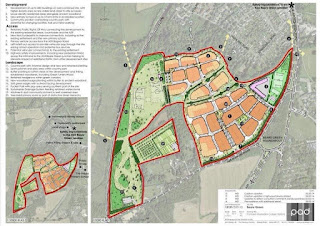BIRDLIFE COULD DECLINE EVEN FURTHER IF WE DO NOT PROTECT OUR OPEN COUNTRYSIDE
BIRDS OF GREAT TURNERS WOOD AND SURROUNDING AREAS
This is a non-exhaustive brief report of the current known birdlife which uses Great Turners Wood and the immediate surrounding areas on a regular basis, including fields and hedgerows behind Springwell Road and Highland Road in Beare Green.
There are
many wild birds that enjoy and use the countryside around Beare Green. Many are
very common and would adapt to varying kinds of habitat including an urban
habitat but there are those that wouldn’t. Many species of birds, like other
wild animals, rely on a particular type of habitat. In the case of where we
live, we are lucky and privileged to have open farmland with hedgerows and much
ancient woodland – which is all part of Beare Green. These habitats are ideal
and indeed essential for the many different species of birds and animals
residing in our area and if we lose this important habitat then we will lose
our birds along with other wild animals. It is already well documented about
birds and animals that are in serious decline, some of which we are still lucky
enough to see around Beare Green. Such species of particular interest to our
area include Bullfinch, Greenfinch, Marsh tit, Tawny owl, & Song thrush –
all reliant on woodland for breeding. Skylark, Lapwing, & Yellowhammer are
more reliant on open fields and hedgerow for breeding.
The skylark is
completely reliant on open fields for breeding.
You may hear one singing high
above the fields behind Highland Rd in the spring and summer
You may see a Marsh tit
if you’re lucky on a feeder in your
Garden in the winter
but they need the woods to breed.
Below is a
list of resident birds that use the area and its peripheries for breeding,
roosting, and feeding and are seen on a regular basis;
House
sparrow, Dunnock, Blue tit, Great tit, Coal tit, Long tailed tit, Marsh tit, Goldcrest,
Starling, Blackbird, Robin, Song thrush, Chaffinch, Goldfinch, Linnet, Greenfinch (declining in numbers rapidly),
Bullfinch (also in decline), Tawny
owl, Wood pigeon, Collared dove, Carrion crow, Jackdaw, Rook, Magpie, Jay,
Kestrel, Sparrowhawk, Buzzard, Red kite
(a likely new breeder), Green
woodpecker, Great spotted woodpecker, Nuthatch, Tree creeper, Grey wagtail,
Pied wagtail, Skylark (another declining
species), Pheasant.
Try walking
round the village sometime and count just how many different birds you see and
hear. Don’t forget to include the Moorhens and Mallards that you’ll see on the
pond!
The beautiful Bullfinch
can be seen in Great Turners Wood but can be quite
secretive and rarely ventures into gardens.
The Greenfinch has
sadly rapidly declined over the last 20 years.
Loss of even more
wooded habitat could wipe them out from local areas completely
Birds that
may visit the area and its peripheries, mainly in winter and have been seen
recently include the following.
Lapwing,
Redwing, Fieldfare, Brambling, Lesser redpoll, Siskin,
Birds that
may visit the area and its peripheries, mainly in summer and have been seen recently
include the following.
Swallow,
House martin, Swift, Chiffchaff, Blackcap, Whitethroat, Cuckoo
Birds that
may occasionally use this area and its peripheries and have been seen in the
past include the following;
Barn owl,
Little owl, Mistle thrush, Yellowhammer.
There are,
needless to say several other birds not listed above which will also be seen in
and around and indeed over our village. Very occasionally there could be quite
an unusual or even rare bird visiting our area so this makes it ever more
important to protect what we have.
I saw a pair of Red
kites very recently flying low over Great Turners Wood.
They seemed to be
‘casing the joint’. How wonderful it would be to have them breed here in Beare
Green








Comments
Post a Comment